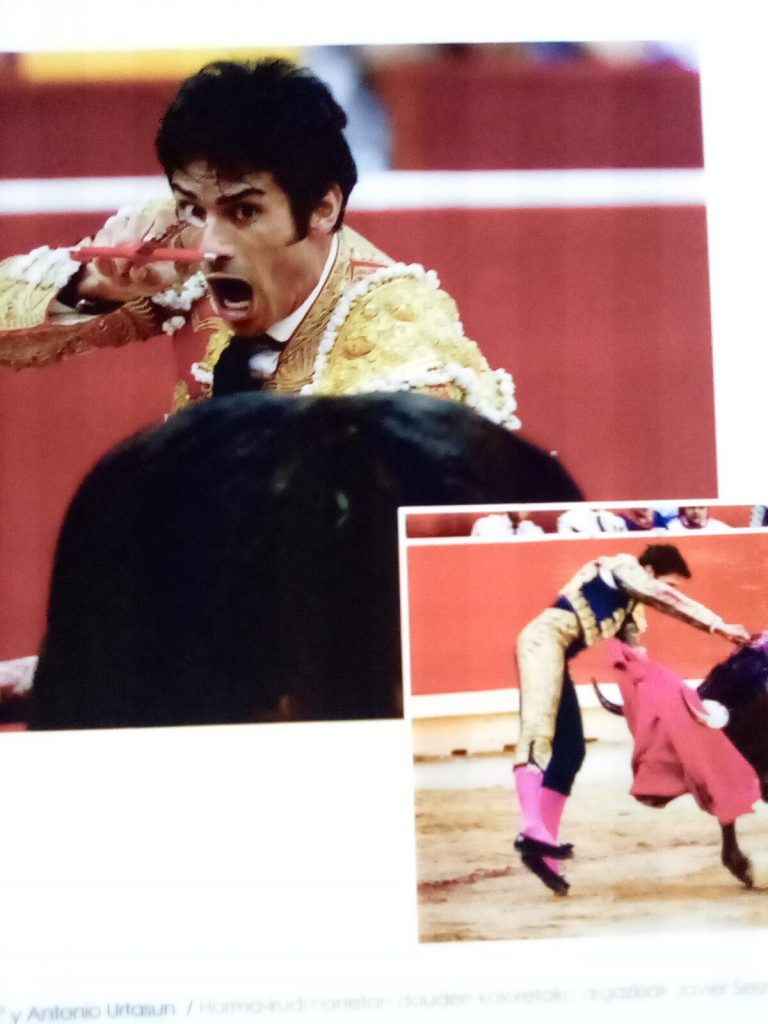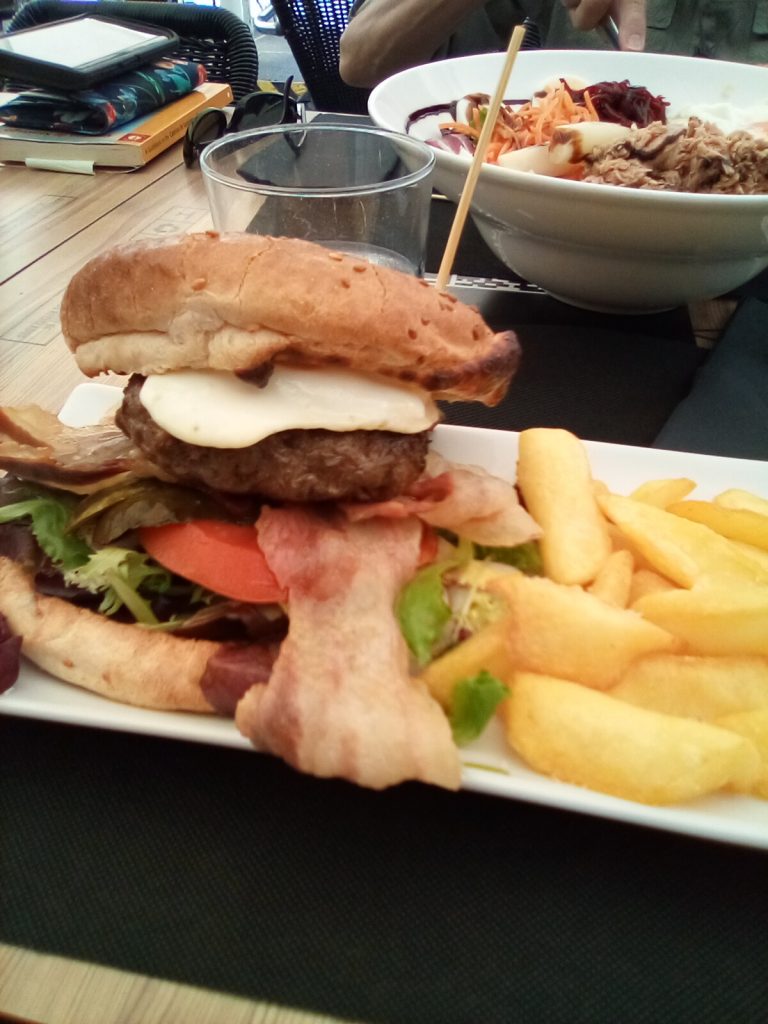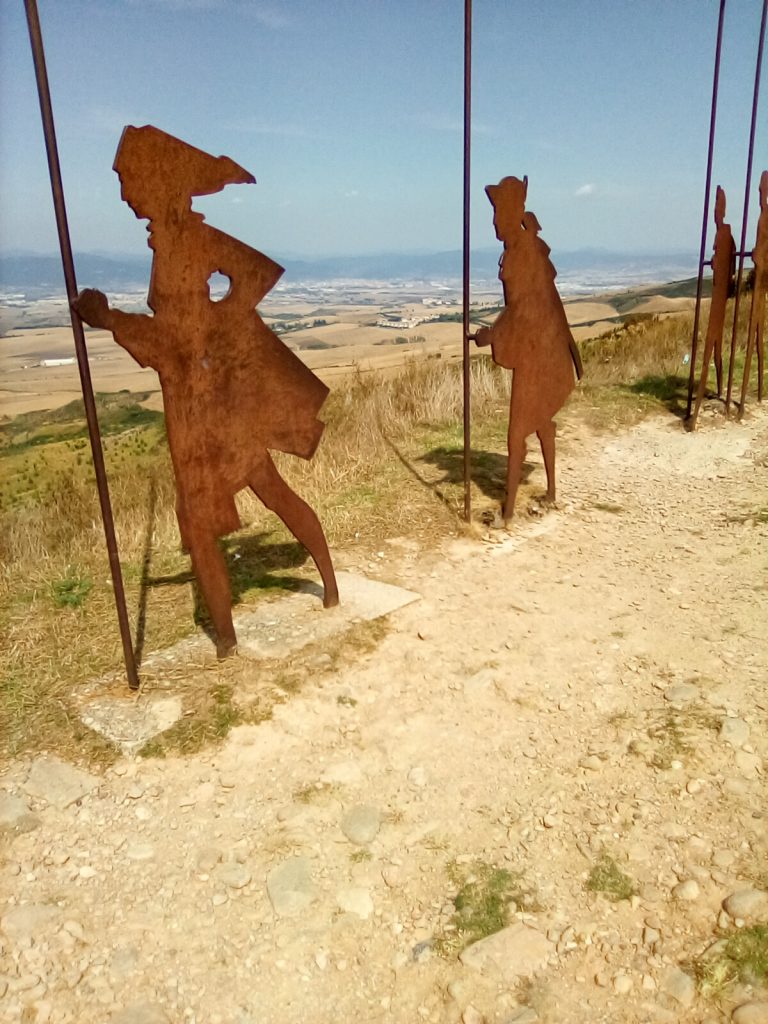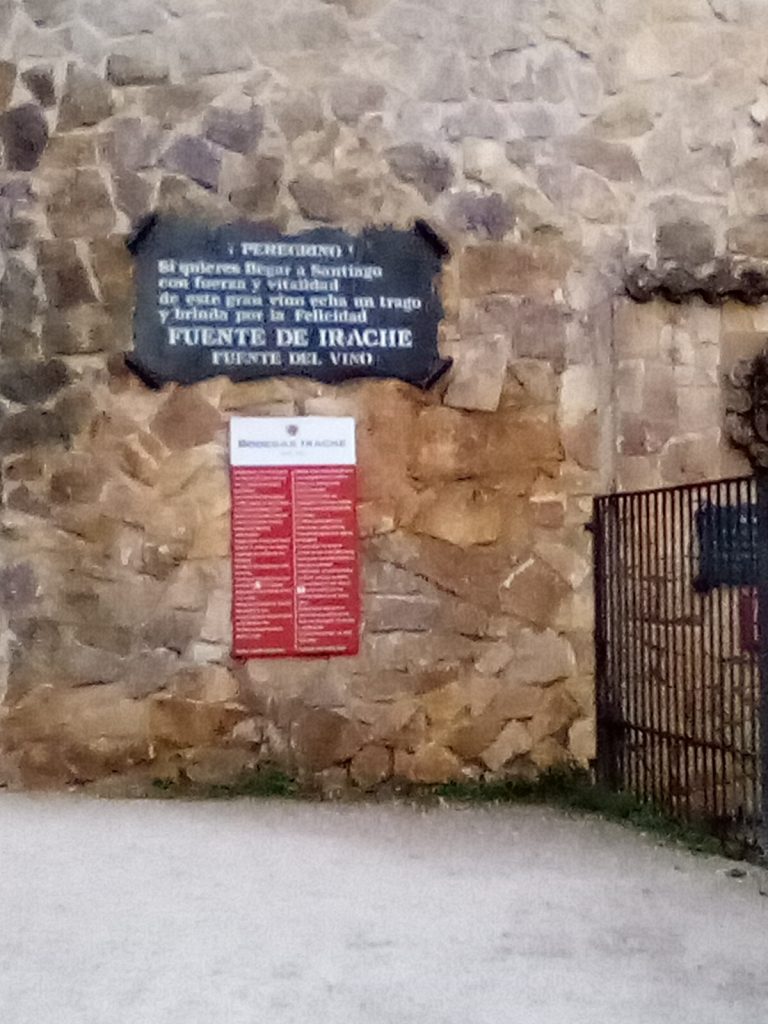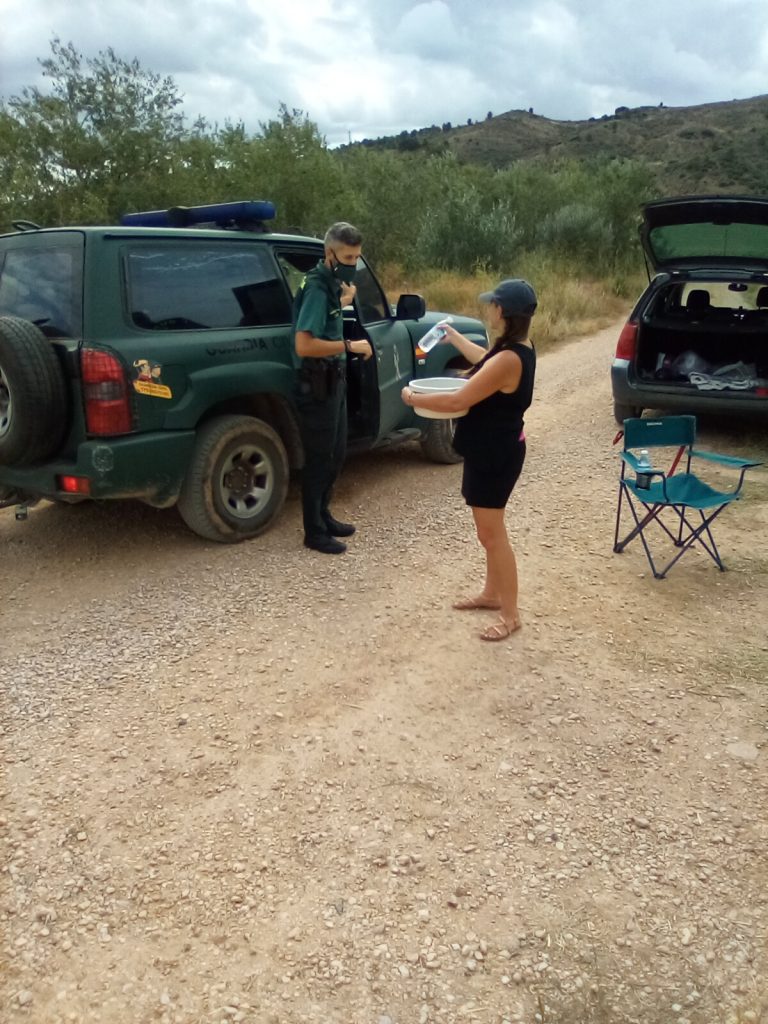
* * * *
Last September I spent a month in France and Spain. Mostly to hike over the Pyrenees Mountain part of the Camino Frances. When I got back home I did posts on arriving in Paris, taking the train down to Saint-Jean-Pied-de-Port, and from there hiking some 177 miles in 17 days. I got the Faithful Reader as far as Pamplona, on September 4. (After arriving in Paris early on the morning of August 26.)
Incidentally, the image at right is from the BULLFIGHTING MUSEUM … Plaza de Toros in Pamplona. And speaking of which, in my last Camino-post I wrote that in the next post I’d discuss more about our day off in Pamplona, “including a touristy visit to the bullring that Hemingway made famous.”
Then I said I’d discuss the 14-day hike to Burgos – with a day off in Logrono – and eventually about making my way back home, via Madrid. (On September 24, 2021.) I added:
I’ll also talk more about the drudgery of hiking, mile after mile, hauling a 15-pound backpack. From my Facebook posts most people would think all I did was drink beer, have great meals and enjoy the sights. “Tra-la-tra-la-tra-la!” But there was real drudgery involved, which seems to be where the spiritual breakthroughs happen… In the meantime, Buen Camino!
But alas, I got side-tracked. By Donald Trump and Holden Caulfield.
And here’s another news flash. In this post I’m only able to get the Faithful Reader as far as Logrono. That’s still 75 miles worth of Camino-hiking to Burgos. And Burgos is where I left the party to head for home, via Madrid, while the other three kept on hiking to Santiago.*
But now I’m back home and “back on the Camino,” if only in spirit. And taking up where I left off, I’ll start back with our first day off, on September 5, after hiking over the Pyrenees. (Eventually I’ll get to the spiritual breakthrough part.) Not surprisingly, that Sunday in Pamplona we slept a bit late, after hiking ten-and-a-half, 13-and-a-half, and 13 miles the previous three days. (A mere five miles on the first day, but it was all uphill.)
Which meant we had a late lunch…
Which brings up how they make hamburgers in Spain. They call them hamburguesas, and they usually come with an egg on top. (A “huevo,” shown above left, along with lots of fatty bacon.) Back home I try to eat healthy, which normally means little or no beef. However, after four days on the Camino – hiking over steep mountains – I was ready for a change. As I wrote later:
I finally broke down and had an Hamburguesa. I told the waiter, “No huevo” – an egg, like they love in Spain on their burgers – but I got the (silly) huevo anyway. At the restaurant in the Plaza del Castillo, next door to the Cafe Iruna.
By the way, I also had two “grande cervezas,” Amstel draft beers. Aside from that we also checked out the route of the Running of the bulls. (Which happened in July. “Dang, we missed it!”) Starting with a pen on the outskirts where the bulls are first gathered and then let loose, to run up the sectioned-off streets to the Plaza del Toros. Two hiking companions and I – Tom’s wife Carol and her brother Ray – paid six euros each to do the tour of the famous bullring.
“Very comprehensive.” For one thing we learned that they pay great attention to the minutest detail, down to exactly the right kind, color and texture of the sand covering the inside of the bullring. (Along with having to have “good drainage.”) Like I said, very impressive.
But mostly we relaxed. In part because starting the next day – Monday, September 6 – we were set to hike six straight days. (59 miles.) But as long as we’re talking about Pamplona, I should say a word or two about the Café Iruña, of Hemingway fame. At least in September 2021, the place was “all crowded and touristy.” Partly because you weren’t allowed to sit inside, where all the “color” is. And our waiter was kind of rude. But the nap we all took later helped out a lot.
There was one other episode of note. We did laundry every night, since we carried only two sets of clothes in our “10 percent of body weight” backpacks. (One set for hiking in and one for relaxing in at night. With some variation, like my bathing suit that could serve as a second pair of shorts, or underwear if need be.) And on this Sunday in Pamplona we also did our wash, and hung our clothes on the lines just outside the windows looking out onto an “atrium” or central court. Then about 6:15 the doorbell rang, as we were relaxing. The guy from the apartment above explained that his wife dropped her bra while hanging it on the line outside their window. As it turned out, it landed on the line where our laundry was hanging.
Being ever the gentleman, I retrieved it. “Always glad to help out a lady in distress…“
* * * *
Leaving Pamplona, we headed for the Hotel Jakue in Puente la Reina. (“Queen’s Bridge.”) On the way we hiked up to and over the Alto de Perdon (“Hill of Forgiveness”), some eight or nine miles out of Pamplona. (With its “remarkable steel sculpture of pilgrims on the road to Santiago” and panoramic views of the surrounding countryside.)
Google Maps says it’s a 14-mile hike from Pamplona to Puente la Reina, but Brierly* says it’s more like 16 miles. (On the Camino.) Either way, we only made it as far as Uterga, some 11 miles from Pamplona. We started late, about 9:00 a.m., a practice we changed as the hike went on. (From that point on we started getting up at 5:30 a.m., mostly because of that first and only time we took a taxi. And felt guilty about it.)
It turned out there were only two places to stop for a drink or whatever the whole 11 miles. One was in Zariquiegui, seven miles out of Pamplona. The other was in Uterga, and by the time we got there it was 6:30 p.m. Which meant five miles left for us to hike in the fading twilight. Thus the feeling guilty, and later getting up at 5:30 and starting the day’s hike in the dark.
But that didn’t happen until the following Thursday and Friday, September 9 and 10.
Tom’s original plan was to hike to Muruzabal, the next town after Uterga, that Monday. But he found out via Wi-Fi – always spotty on the Camino – that the place in Muruzabal cancelled on him. (That happened a lot this trip, which kept Tom constantly checking the reservations he’d made.) Then there was the taxi ride from Uterga to Pamplona. (Where Tom made an alternate reservation.) But as it turned out, that re-assignment to Pamplona cut out miles from Tuesday’s hike. (Back home I tried to figure out exactly how many, but for now I’ll let the Reader do the math, if “they” so choose. It’s enough to say it made a big difference on Tuesday’s hike.)
And now a word about those mileage calculations. The Brierly guidebook sets out distances in kilometers, with one page generally representing a hike of 15 miles per day. But being in a small, 4.5 x 7.5-inch format, the maps are far from being accurate in scale. Then there were side trips. As an alternative, Carol kept count of “steps walked,” on her fancy-schmancy wrist watch. (Which also had GPS, which quite often helped us better find the lodging on a given night, usually a rental apartment with no “outward and visible sign” of its location.)
For myself, I kept count of “minutes spent actually hiking.” (Via my own wrist watch, a ten-dollar much-less-fancy-schmancy Walmart special.) So for the 10.9 miles we spent hiking on Monday, I listed 230 minutes of actual hiking. That system worked well for the 2017 and 2019 Camino hikes, but for some reason this year we took a whole lot more “standing stops,” especially when we were hiking up to and over the Pyrenees. But for that system to accurately reflect a medium intensity aerobic workout, you have to go at it for at least ten minutes straight. So, to make up for the frequent standing stops this trip, I’d walk a certain number of paces – after each stop – before starting up the stop-watch again.
Which is relevant to me but boring to you, so let’s get back to “Camino 2021…”
Tuesday we left the Hotel Jakue* in Puente la Reina and hiked about 8.5 miles to the Casa Nahia in Lorca. (I had it as 130 minutes of actual hiking, with “lots of breaks.”) And for the first time on this trip we finally found a place in the morning for a place to stop and get a cafe con leche, in Maneru. Wednesday was a short day, a little over five miles hiking to Estella. We were able to check in a 3:00, so I took a nap and did some yoga. We had dinner at 6:30 in the Estella town plaza, packed and busy. “Lots of people promenading, kids playing soccer, cute girls roller skating.” Definitely a pleasant dinner, but “tomorrow, a long day, up at 5:30 a.m.”
And by the way, I realize this post is way longer than I like to do normally, but I’m trying to get at least to Logrono, on Saturday, September 11. Besides, I figure on using these posts for a new book I’ll start writing in 2022. On all three Camino hikes, 2017, 2019 and 2021, so bear with me…
Getting back to the Camino, on Thursday, September 9, we got up at 5:30 and left Estella while it was still dark. (And took some wrong turns getting out of the city.) We hiked from 6:30 a.m. to 3:30 p.m. That nine hours on the trail I calculated as 220 minutes actual hiking. (Three hours and 40 minutes, which gives you an idea of the discrepancy.) That day there was a long stretch of nothing. After seven hours hiking, with no place to stop and get a drink, we ran across what seemed to be a mirage; too good to be true. Complete strangers handing out free water…
The Brierly guidebook shows a “Cafe movil” some seven hours out of Estella and about 3.8 miles short of Los Arcos, our goal for the day. The one place to stop came right at the start of the day’s hike, at the Irache Wine Fountain – the “Fuente de Irache” – a mere half-mile or so out of Estella. (The “owners of Bodegas Irache have kindly put a wine fountain, so that pilgrims can serve themselves a free glass of red wine to help them on their way.”) I added a smidge – or more precisely, a dram – of wine to my water bottle: 1) I didn’t want to get too tipsy on the long day’s hike ahead, and 2) in compliance with 1st Timothy 5:23.
Other than that there was no place to stop for seven long hours of hiking. (We went through some villages that had cafes open in 2017, but this year they were closed for the COVID.) Then too, when we got to where Brierly listed a “mobile cafe,” it wasn’t there. What was there was a group of three people, as noted, handing out free cold water. (See “The Camino provides.”) And one of them was “Sweet Katie from Alabama,” pictured at the bottom of the main text. Katie and her co-workers were from the “Pilgrim’s Oasis” in Viana, Spain. See Pilgrims’ Oasis – Home | Facebook. And Viana was a mere six miles shy of Logrono, where this post ends.
Katie and I had a nice long chat. (For one thing it was nice to talk to someone outside the group who also spoke English.) She was 33, had been married but no kids, and was now divorced. She was in Spain for three weeks or so, volunteering to help out at Pilgrim’s Oasis. I noticed a tiger on her ball cap so I said, “You’re an Auburn fan?” She answered, “Only somebody from the South would know that.” All things considered that free cold water and nice chat with a lady from Back Home definitely lifted my spirits – after that long seven hours of hiking, with “nary a place to stop for a cold drink.” I took a couple pictures of her – she could have been a model – with the one below showing her charming someone else. (One of the local Guardia Civil, stopping by to check out the situation. “Wait. You’re giving out free cold water?”)
* * * *
So anyway, that Thursday the 9th, we hiked from Los Arcos to Viana. 11.4 miles or 220 minutes of actual hiking time. The day was mostly overcast, with some sprinkles of rain. Once again we got up at 5:30, in the dark, and reached the apartment in Viana at 1:52 p.m. I won the draw and so got a room to myself. (The others shared a room or slept on the living room couch.) Then too there was a mini-bar, with four cold beers that cost only a euro apiece. “I’m in heaven!”
Which is almost a pretty good place to stop. Except to say that Saturday’s hike from Viana to Logrono was a mere six miles, which gave us time to stop by the Pilgrim’s Oasis in Viana and say hello to Katie one more time. (Before she left for Back Home in a week or so.) And we got to stay in Logrono for a well-deserved day off from hiking, after six days straight. In the next – and hopefully final – post on this year’s Camino adventure, I plan to get the Faithful Reader from Logrono to Burgos, and from there down to Madrid. At which point I’d have to take another COVID test within 72 hours of my flight home. And if I failed that test I would find out what it means to be quarantined in Spain for 14 days. In the meantime:
Buen Camino!
* * * *
* * * *
The upper image is courtesy of Pamplona – Wikipedia. The caption: “Encierro de San Fermín.” In Spanish “encierro” can mean confinement or prison, but as usually translated refers to a bull-run where “bulls are driven through streets to a bullring.” The running of the bulls in Pamplona happens during the San Fermín festival, “held annually from July 6 to July 14. This festival was brought to literary renown with the 1926 publication of Ernest Hemingway‘s novel The Sun Also Rises.”
For more on the four days in Paris, see A post-trip post mortem for “Paris – 2021.” About visiting the Picasso Museum, and the outer part of the being-rebuilt Notre Dame cathedral, and getting the Covid test – required to get on a train – at a sidewalk clinic just off the Pont Neuf on the Left Bank.
Re: “170 miles in 17 days for me,” and leaving for home in Burgos. I had already hiked the Camino from Pamplona to Santiago in 2017, as noted in previous posts. Thus I finished my portion of the hike, in Burgos, on Sunday, September 19, while the other three finished up in Santiago de Compostela on October 26.
Re: 10 percent of body weight. The link is to 10 Essential Tips for Hiking the Camino de Santiago, including “the weight of your backpack should not exceed 10 percent of your body weight. Keep in mind that the magic “10 percent” number includes your water for the day, so factor in a bit of wiggle room.” In my case, my backpack should not have weighed over 14.5 pounds, including water.
Re: “Brierly.” That’s the Pilgrim’s Guide to the Camino de Santiago: Camino Francés, by John Brierley. This “comprehensive guidebook to the Camino de Santiago and its offshoots contains all the information needed by modern-day pilgrims wishing to walk the sacred Way of St. James.”
Re “Dram.” Defined in part as small amount of an alcoholic drink.
See also 8 Words for Small Amounts | Merriam-Webster.
Re: 1st Timothy 5:23. “Stop drinking only water, and use a little wine because of your stomach and your frequent illnesses.” And of course as a prophylactic precaution against snake bite…
* * * *
Here are some other notes from earlier posts I did on the trip:
I flew into Paris last August 25, 2021. I spent four days there, meeting up with three other family members on the 28th. After that the four of us took a train down to Saint-Jean-Pied-de-Port, starting point for the Camino Frances. From there we started a long hike over the Pyrenees Mountains into Spain. (170 miles in 17 days for me.*) On the second day’s hike “we got up fairly early for the remaining 10.5-mile hike to Roncesvalles. (A ‘small village and municipality in Navarre, northern Spain.’) On the Route de Napoleón it’s about five miles past the border with France. From Roncesvalles we hiked 13.6 miles to Zubiri on Friday, September 3, and on Saturday the 13 miles to Pamplona.”
That pilgrimage-by-hiking usually ends at Santiago de Compostela, in northwestern Spain. But I stopped in Burgos, thus finishing the unfinished business of not hiking over the daunting Pyrenees back in 2017. I detailed that accomplishment in Hiking over the Pyrenees … finally, but in that October 16 post only got as far as Pamplona.
